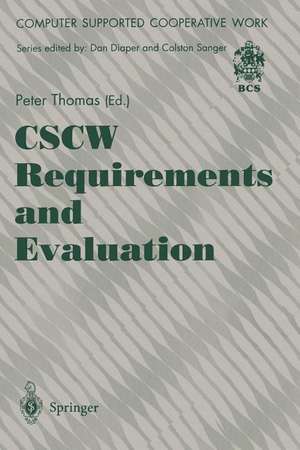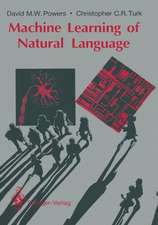CSCW Requirements and Evaluation: Computer Supported Cooperative Work
Editat de Peter Thomasen Limba Engleză Paperback – dec 1995
Din seria Computer Supported Cooperative Work
- 20%
 Preț: 1044.25 lei
Preț: 1044.25 lei - 20%
 Preț: 650.59 lei
Preț: 650.59 lei - 20%
 Preț: 647.61 lei
Preț: 647.61 lei - 20%
 Preț: 638.55 lei
Preț: 638.55 lei - 20%
 Preț: 334.53 lei
Preț: 334.53 lei - 20%
 Preț: 328.79 lei
Preț: 328.79 lei - 20%
 Preț: 334.71 lei
Preț: 334.71 lei - 20%
 Preț: 330.90 lei
Preț: 330.90 lei - 20%
 Preț: 328.79 lei
Preț: 328.79 lei - 20%
 Preț: 649.28 lei
Preț: 649.28 lei - 20%
 Preț: 643.50 lei
Preț: 643.50 lei - 20%
 Preț: 329.91 lei
Preț: 329.91 lei - 15%
 Preț: 642.83 lei
Preț: 642.83 lei - 20%
 Preț: 648.11 lei
Preț: 648.11 lei - 20%
 Preț: 996.40 lei
Preț: 996.40 lei - 20%
 Preț: 647.79 lei
Preț: 647.79 lei - 20%
 Preț: 413.81 lei
Preț: 413.81 lei - 20%
 Preț: 336.02 lei
Preț: 336.02 lei - 20%
 Preț: 346.10 lei
Preț: 346.10 lei - 20%
 Preț: 330.24 lei
Preț: 330.24 lei - 20%
 Preț: 982.36 lei
Preț: 982.36 lei - 20%
 Preț: 329.11 lei
Preț: 329.11 lei - 20%
 Preț: 987.32 lei
Preț: 987.32 lei - 20%
 Preț: 648.26 lei
Preț: 648.26 lei - 20%
 Preț: 995.89 lei
Preț: 995.89 lei - 20%
 Preț: 643.63 lei
Preț: 643.63 lei - 20%
 Preț: 988.98 lei
Preț: 988.98 lei - 20%
 Preț: 328.42 lei
Preț: 328.42 lei - 20%
 Preț: 988.81 lei
Preț: 988.81 lei - 20%
 Preț: 643.30 lei
Preț: 643.30 lei - 20%
 Preț: 987.17 lei
Preț: 987.17 lei - 20%
 Preț: 329.58 lei
Preț: 329.58 lei - 20%
 Preț: 309.58 lei
Preț: 309.58 lei - 20%
 Preț: 330.42 lei
Preț: 330.42 lei - 5%
 Preț: 365.82 lei
Preț: 365.82 lei - 20%
 Preț: 650.08 lei
Preț: 650.08 lei - 20%
 Preț: 334.38 lei
Preț: 334.38 lei - 20%
 Preț: 645.79 lei
Preț: 645.79 lei - 20%
 Preț: 650.40 lei
Preț: 650.40 lei - 20%
 Preț: 333.88 lei
Preț: 333.88 lei - 20%
 Preț: 1263.81 lei
Preț: 1263.81 lei - 20%
 Preț: 830.58 lei
Preț: 830.58 lei - 20%
 Preț: 704.70 lei
Preț: 704.70 lei
Preț: 641.34 lei
Preț vechi: 801.68 lei
-20% Nou
Puncte Express: 962
Preț estimativ în valută:
122.71€ • 128.14$ • 101.34£
122.71€ • 128.14$ • 101.34£
Carte tipărită la comandă
Livrare economică 16-30 aprilie
Preluare comenzi: 021 569.72.76
Specificații
ISBN-13: 9783540199632
ISBN-10: 3540199632
Pagini: 212
Ilustrații: XV, 192 p. 2 illus.
Dimensiuni: 155 x 235 x 11 mm
Greutate: 0.3 kg
Ediția:Softcover reprint of the original 1st ed. 1996
Editura: SPRINGER LONDON
Colecția Springer
Seria Computer Supported Cooperative Work
Locul publicării:London, United Kingdom
ISBN-10: 3540199632
Pagini: 212
Ilustrații: XV, 192 p. 2 illus.
Dimensiuni: 155 x 235 x 11 mm
Greutate: 0.3 kg
Ediția:Softcover reprint of the original 1st ed. 1996
Editura: SPRINGER LONDON
Colecția Springer
Seria Computer Supported Cooperative Work
Locul publicării:London, United Kingdom
Public țintă
ResearchCuprins
1 Introduction.- 2 CSCW and Requirements Analysis: Requirements as Cooperation/Requirements for Cooperation.- 2.1 Introduction.- 2.2 Promoting Cooperation in Requirements.- 2.3 Cognitive Mapping.- 2.4 Empirical Results.- 2.5 Conclusion.- 3 “They’re Supposed to be Fixing it”: Requirements and System Redesign.- 3.1 Introduction.- 3.2 The “nth” Phase in the Requirements Process?.- 3.3 Considering Systems in Use.- 3.4 The Bank.- 3.5 Conclusion: “Requirements” and “Configuring the User”.- 4 Cooperation, Requirements Analysis and CSCW.- 4.1 Introduction.- 4.2 Approaches to Requirements Analysis.- 4.3 Characteristics of Group Session Approaches.- 4.4 Research Issues.- 4.5 Prototype CRC Tools.- 4.6 Evaluation of the CRC Prototype.- 4.7 Research Issues for CSCW.- 5 User Requirements from a Group Perspective: The Case of Distance Learning Mediated by Computer Conferencing.- 5.1 Introduction.- 5.2 On Approaches to the Evaluation of CCS.- 5.3 Objectives of Case Study.- 5.4 Case Study: Distance Learning via Computer Conferencing.- 5.5 Examining the Social Organisation of the Students’ Learning Activity in the CCS Environment, and the Problems they Encountered.- 5.6 Investigation of Participants’ Communication Problems.- 5.7 Some General Implications.- 5.8 Summary of Other Findings.- 5.9 Recommendations and Further Development.- 5.10 Conclusions.- 6 Early Evaluation of the Organisational Implications of CSCW Systems.- 6.1 Organisational Impact.- 6.2 Approaches to Evaluation.- 6.3 The User Cost-Benefit Assessment Method.- 6.4 Evaluating the Impact of a Mobile Communications System.- 6.5 Reflections on the Use of the User Cost-Benefit Assessment Method.- 6.6 Conclusions.- 7 Coordination Breakdowns: How Flexible is Collaborative Work?.- 7.1 Introduction.- 7.2 EMailand Communication Problems.- 7.3 Definitions.- 7.4 The Role of Breakdowns.- 7.5 Discussion.- 7.6 Conclusions.- 8 The Why, How and What to Evaluate of Interaction Technology: A Review and Proposed Integration.- 8.1 Introduction.- 8.2 HOW to Evaluate: Methodology for Interaction Technology.- 8.3 Four Research Traditions.- 8.4 Choice of Evaluation Approach.- 8.5 WHAT to Evaluate: A Model of Distributed Social Interaction.- 8.6 Group Evolution.- 8.7 The Complete Evaluation Process.- 9 Measures of Process.- 9.1 Introduction.- 9.2 Common Ground, Effort and Social Salience.- 9.3 Surface Features of Conversational Content.- 9.4 Conversational Structure.- 9.5 Discussion.- 9.6 Conclusions.- 10 Dealing with Uncertainty — Perspectives on the Evaluation Process.- 10.1 Introduction.- 10.2 Evaluation in a Specific Context — Retail Financial Services.- 10.3 Conclusion — What is Evaluation?.- 11 The Use of Breakdown Analysis in Synchronous CSCW System Design.- 11.1 Introduction.- 11.2 Background.- 11.3 Usability Evaluation and CSCW.- 11.4 Breakdown Analysis.- 11.5 Conclusions.- References.- Name Index.
















